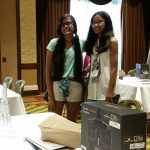[amazon template=banner easy]
SheDrones excited the students and adults at the 2016 Women in Technology International (WITI) Summit with a STEM program to engineer a drone quadcopter.
[metaslider id=787]

Women in Technology International (WITI) Summit 2016 in San Jose, CA. SheDrones offered an opportunity for young girls to design, engineer, program and fly drone quadcopters. Leslie Bates, the founder of SheDrones, Anne Lopez, the developer of the STEM education curriculum, Don E. Yeoman, audio visual, flight control and training assistant, and Desi Ekstein the sUAS flight operator and flight controller make up the team for SheDrones. The goal of SheDrones is to empower students to pursue an education and career in science. The program is designed to address the country’s need for more female innovators, employees, leaders and entrepreneurs in the unmanned aerial systems (UAS) industry. The excitement and enthusiasm at the event was so high the students and adults wanted to get involved.

Starting with … what’s in the bag? Curiosity was peaked when the brown paper bag was handed out and the first engineering design was set in motion. The music went on and the tower build began. The goal of the first exercise was to introduce the students to engineering discovery, design, create, and test concept by building the tallest free standing tower from the items inside the bag (a handful of small clear cups). This is when the adults felt the students were having too much fun and wanted to join in.
SheDrones and the STEM based curriculum had everyone buzzing!
The tables were full, everyone was teamed up and ready. It was time for the drone engineering. Each table had a box of drone parts, a RC controller, and a Chromebook. The box had all the parts needed to build the drone: ESC’s (Electronic Speed Control), flight controller, frames, black screws, gold screws…. so many options for the possible design. Anne Lopez reminded everyone of the engineering process: discovery, design, create, test. Music and excitement filled the room and everyone came up with a plan for their drone design. Next step, create the drone from their design. All had the same parts, but no two drones were the same. Each student (including the parents) had their own engineering ideas.

After the drone had been built, communication between the drone and the RC controller needed to be established. The students now had to use the software on the Chromebook to program the controller. They adjusted button functions and sensitivity. They programed specific flight modes between “angle”, “horizon” and “manual”. Students also programmed the alarm buzzer to notify them of communication loss between the drone and controller. Buzzers were sounding off everywhere!
The final step was to test fly their newly created drone. With high anticipation, all the student engineers stepped up to the safety net flying area. Of course, some drones flew better than others. Some had lift off… some had “take off”, and like all good engineering processes, some had to go back to the design board several times. In the end, they all did lift and motors running! A very proud moment for all the participants.
The half-day session with SheDrones at the Women in Technology International allowed students to explore new capabilities in STEM education as the girls worked in teams to design and build a quadcopter drone from beginning to end. Drones have a “cool factor”, and the drone engineering workshop for the middle school and high school girls at the WITI event was a success!


